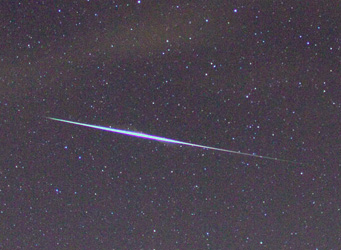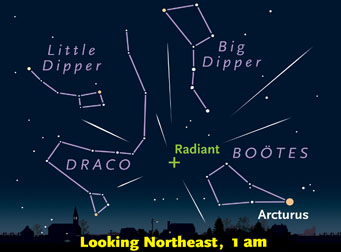The Quadrantid meteors are among the year's best meteor showers. But North Americans will probably miss the shower's brief peak on January 3rd.

It's the only Quadrantid meteor captured in 2011 by Maryland skywatcher Mike Hankey during 10 hours of photography, but it's a doozy. Click here for a larger view.
Mike Hankey
Of all the displays of "shooting stars" that appear each year, calendrically the first — and one of the best — is the Quadrantid meteor shower.
The good news is that night sky will be Moonless when the shower peaks on Friday, January 3rd. The bad news is that this notoriously brief shower is predicted to climax around 19:30 Universal Time. That's ideally timed for eastern Asia (before dawn on the 4th). But it'll daylight across much of North America.
According to one estimate, the peak might occur a few hours earlier, which means those of you on the West Coast could see activity before dawn on the 3rd.
Depending on your point of view, the "Quads" are the least-known major meteor shower or the best of the minor showers. Some observers report more than one meteor per minute from dark sites.

Not until early morning does the radiant of the Quadrantid meteor shower start to rise high. (And don’t expect to see several at once!) This scene is for 40° north latitude.
Sky & Telescope illustration
This shower gets its name from the obsolete constellation Quadrans Muralis, the Mural Quadrant, that was located in a dim region about halfway from the end of the Big Dipper’s handle to the head of Draco. That's where these meteors appear to radiate from as they arrive. Their source is not a comet, as is typical for showers, but rather an asteroid called 2003 EH1. Dynamicists suspect it is a dead chunk of a comet that broke apart several centuries ago, and that the meteors are small bits of debris from this fragmentation.
Because the Quadrantids are so brief, and because they're only visible from northerly latitudes at the coldest time of night during the coldest part of winter, this shower isn't very well documented. There's a strong suspicion that the Quadrantids vary a lot from one year to the next, but this might just be a statistical fluke due to the relatively small number of reports.
If you venture out, make sure to stay warm. Bundle up in as many clothes as possible, paying especial attention to your head, and then snuggle into a warm sleeping bag. Relax in a reclining chair to keep you off the cold ground, and if possible, put an insulating pad between the chair and your sleeping bag. And don't forget to have fun!
 1
1









Comments
KC
December 31, 2013 at 9:04 am
I've seen several articles over the past fews days that have been overhyping this shower - this is the only article I've seen that gets it right! Bravo!
You must be logged in to post a comment.
You must be logged in to post a comment.